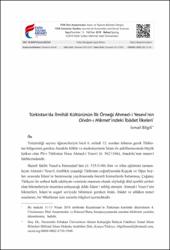| dc.contributor.author | Bilgili, İsmail | |
| dc.date.accessioned | 2019-06-28T09:00:29Z | |
| dc.date.available | 2019-06-28T09:00:29Z | |
| dc.date.issued | 2019-06 | |
| dc.identifier.citation | BİLGİLİ, İsmail. "Türkistan’da İlmihâl Kültürünün İlk Örneği Ahmed-i Yesevî’nin Divân-ı Hikmet’indeki İbâdet İlkeleri." FSM İlmî Araştırmalar İnsan ve Toplum Bilimleri Dergisi, 13 (2019): 33-56. | en_US |
| dc.identifier.uri | https://dergipark.org.tr/fsmia/issue/46340/582341 | |
| dc.identifier.uri | https://hdl.handle.net/11352/2864 | |
| dc.description.abstract | Yetiştirdiği sayısız öğrencileriyle hicrî 6. miladi 12. asırdan itibaren gerek Türkistan
bölgesinin gerekse Anadolu kültür ve medeniyetinin İslam ile şekillenmesinde büyük
katkısı olan Pîr-i Türkistan Hoca Ahmed-i Yesevî (ö. 562/1166), Anadolu’nun manevî
fatihlerindendir.
Hanefi fakîhi Yusuf-u Hemedanî’den (ö. 535/1140) ilim ve irfan eğitimini tamamlayan
Ahmed-i Yesevî, özellikle yaşadığı Türkistan coğrafyasında Kıpçak ve Oğuz boyları
arasında İslam’ın benimsenip yayılmasında önemli hizmetlerde bulunmuş, Çağatay
Türkçesi ile serbest halk edebiyatı vezninde manzum olarak söylediği dînî içerikli şiirleri
olan hikmetleriyle insanlara anlayacağı dilde İslam’ı tebliğ etmiştir. Ahmed-i Yesevî’nin
hikmetleri, İslam’ın asgarî seviyede bilinmesi gereken îmân, ibâdet ve ahlâkın temel
esaslarını, bir Müslüman için zorunlu bilgileri içermektedir.Türkler arasında gelişip yayılan ve ilk örneğini Ahmed-i Yesevî’nin Divân-ı Hikmet
eseriyle veren îmân, ibâdet ve ahlâka dair asgarî bilgilerin genel prensipler mâhiyetinde
ele alındığı ilmihâl geleneği, Cibrîl hadîsinde yer alan üç konuyla ilgili sorulara yönelik
îzâhın yaygınlaşmasıyla oluşmuştur. Ahmed-i Yesevî, hikmetlerinde bu bilgilere, ahkâm
cihetinden değil, dînîn özünü oluşturan ilkeler bakımından yer vermiş, insanların İslam
ile olan bağını sahih bir yolla kurma amacını hedeflemiştir.
Ahmed-i Yesevî’nin, ilmihâl konularından ibâdetlere verdiği hassasiyeti, Divân-ı
Hikmet’te ibâdetin gereğine değindiği sayısız hikmetleriyle birlikte 68 yerde namazdan,
otuz üç yerde oruçtan, üç yerde zekâttan bahsetmesi ile de görmekteyiz. Ayrıca dokuz
kıtadan oluşan 242. hikmetini sadece hac ibâdetine ayırması da bu kanaati desteklemektedir.
İlmihâl kültürünün oluşumu hakkında kısa bilgi verdikten sonra Ahmed-i Yesevî’nin
hikmetlerinde zâhirî hükümlerinden ziyâde iç anlamları yani manevî boyutları üzerinde
durduğu ibâdet konularını ele alacağımız çalışmamızda, Divân-ı Hikmet’ten tespit ettiğimiz
bazı ibâdet ilkelerini hikmetler ışığında sunacağız. | en_US |
| dc.description.abstract | Hodja Ahmad-i Yasawi (d. 1166) with his many students, VI / XII. it has been a great
contribution both from Turkestan and from Anatolia in the shaping of Anatolian culture
and civilization with Islam. He is the spiritual conqueror of Anatolia.
Ahmad-i Yasawi completed the education of knowledge and wisdom from the Hanafi
physician Yusuf-u Hemedani (d. 1140). Ahmed-i Yasawi, the almighty VI / miladi XII.
In the geographical region of Turkistan, Kipchak and Oguz had important services in the
adoption and spread of İslâm. Ahmad-i Yasawi notified Islam on the level of understanding
the people with his wisdoms with religious content poems which he said as a poem
in Chagatay Turkish and free folk literature.
The wisdom of Ahmad-i Yasawi is that the basic principles of faith, worship and
morality that İslâm needs to be known at the minimum level include the minimum level
necessary for a Muslim. Although the wisdoms are not predominant, the wisdom gives
the impression of infallibility, including the essential principles that every Muslim needs
to acquire about faith, worship and general morality, and the essential information he
needs to learn.The tradition of ilmihal, which is developed and spread among the Turks and the
first principles of which are given in the general principles of faith, worship and morality,
giving the first example with the work of Divan-i Hekmat of Ahmad-i Yasawi, explains
the internal meaning of the questions of Islam and benevolence. Yasawi places this information
in his wisdom as the basis of the spirit of religion, and aims to secure people’s
faithfulness to İslâm in a safe way. The connection with the deed is a form of encouragement
to him, an attachment of significance and a neglect of his negligence. Islamic
faith and jurisprudence of İslâm in Turkistan was learned and taught through the books
of kelâm and fiqh.
We see the sensitivity of Yasawi to the worship of the subjects of science, the prayer
in 68 places in the Divan-ı Hekmat, the fasting in 33 places and the zakat in 3 places. It
is also supported by the fact that the 242th Hekmat, which consists of nine continents, is
only used for pilgrimage. Yasawi emphasizes the importance of ablution and places sacrifice
and itikaf subjects in his wisdom in using ablution on the basis of worship.
After giving brief information about the formation of the almighty cult, we will discuss
the issues of worship which Ahmad-i Yesevî emphasizes on inner meanings / spiritual
dimensions rather than the spiritual meanings in his wisdom. In this paper, we will
try to present some principles from the Divan-ı Hekmat that we have determined for the
principles of worship. | en_US |
| dc.language.iso | tur | en_US |
| dc.publisher | FSM Vakıf Üniversitesi | en_US |
| dc.rights | info:eu-repo/semantics/openAccess | en_US |
| dc.subject | Fıkıh | en_US |
| dc.subject | İlmihâl | en_US |
| dc.subject | İbâdet | en_US |
| dc.subject | Ahmed-i Yesevî | en_US |
| dc.subject | Divân-ı Hikmet | en_US |
| dc.subject | Fıqıh | en_US |
| dc.subject | Ilmihal | en_US |
| dc.subject | Worship | en_US |
| dc.subject | Ahmad-i Yasawi | en_US |
| dc.subject | Divan-ı Hekmat | en_US |
| dc.title | Türkistan’da İlmihâl Kültürünün İlk Örneği Ahmed-i Yesevî’nin Divân-ı Hikmet’indeki İbâdet İlkeleri | en_US |
| dc.title.alternative | The Background of the Ilmihal Clavicle in Turkestan: Islamic Worship Principles in Ahmad-i Yasawi’s Divan-i Hekmat | en_US |
| dc.type | article | en_US |
| dc.contributor.department | FSM Vakıf Üniversitesi, FSM İlmî Araştırmalar İnsan ve Toplum Bilimleri Dergisi | en_US |
| dc.relation.publicationcategory | Makale - Ulusal Hakemli Dergi - Kurum Öğretim Elemanı | en_US |



















